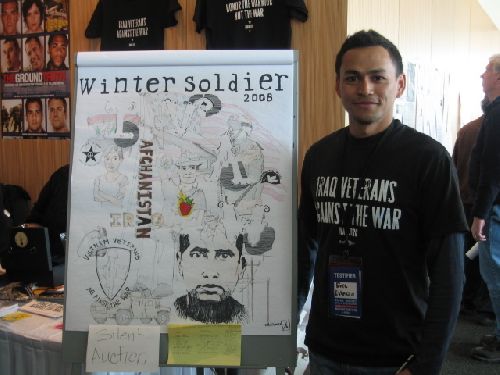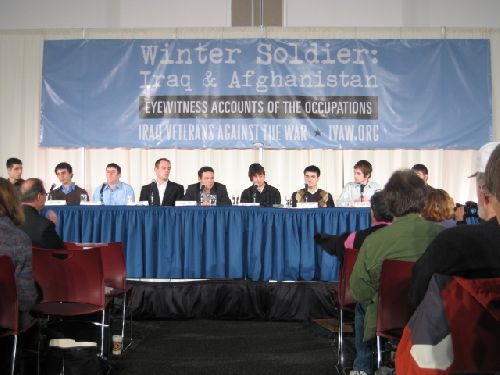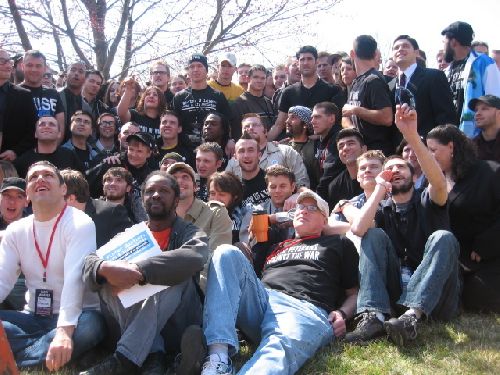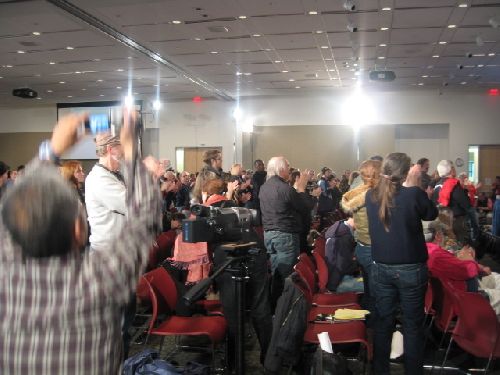Chicago Indymedia : http://chicago.indymedia.org/archive
News :: Protest Activity
Winter Soldier: Iraq and Afghanistan
From March 13-16, members of the Iraq Veterans Against the War spoke out in Silver Spring, Maryland
From the White House on March 14 President George W. Bush spoke to U.S. soldiers during a video conference about their current deployment in Afghanistan. “I’m a little envious. If I were slightly younger and not employed here, I think it would be a fantastic experience to be on the front lines of helping this young democracy succeed. It must be exciting for you … in some ways, romantic … you know, confronting danger,” Bush said.
Romantic was not the picture painted of the wars in Iraq and Afghanistan just a few miles away in Silver Spring, Maryland, during the second day of testimony by U.S. veterans during Winter Soldier: Iraq and Afghanistan , organized by the Iraq Veterans Against the War. “For those of you who don’t know, those are brains,” said Jon Turner, a former Marine, while showing a slide of the inside of man’s head who had been killed by one his friends in his platoon.
Turner and other soldiers on the Rules of Engagement panel depicted their tours of duty in Iraq and Afghanistan as horrifying events, in which civilians were indiscriminately killed, both accidentally and intentionally, soldiers wantonly destroyed property, including mosques, conducted house raids, planted weapons on civilians killed by the U.S. military in order to be able to classify their deaths as insurgents, and mutilated the dead.
“I want to apologize to all the people in Iraq,” said Sergio Kochergin abruptly, breaking off the end of a story about a friend who had shot himself in the shower, four days after arriving in Iraq. “I’m sorry and I hope this war is going to be over as soon as possible.”
Kochergin’s testimony helped establish how the Rules of Engagement employed by soldiers in Iraq and Afghanistan lead to many of the atrocities described the soldiers. The rules, which are provided to soldiers ahead of any mission, define when and how soldiers can fire their weapons or engage in combat. Kochergin described how initially his platoon, which patrolled an Iraqi town on the Syrian border, had to radio to the command post and “if they’re doing some sort of illegal activity, we were allowed to take them out.”
After a while though, these rules were abandoned by commanders, who, at one point, told soldiers to fire at any Iraqis carrying bags and shovels, assuming that they were planting explosive devices. Finally, the soldiers were given no rules of engagement at all, “it was up to us to make the decision,” said Korchergin, who called that policy “inappropriate.”
For many soldiers in Iraq, the rules of engagement in Iraq were “broadly defined and loosely enforced, anyone who tells you different is a liar and a fool,” said Jason Lemieux, who served three tours of Iraq in the U.S. Marine Corps. While he was initially given rules of engagement that corresponded to the Geneva Conventions, “By the time we got to Baghdad that I could shoot at anyone who came close enough to make uncomfortable,” said Lemieux, who described being so traumatized by the shooting of an unarmed Iraqi man that he blocked it out, a commanding officer who shot “two old ladies carrying groceries” and fellow soldiers taking potshots at unarmed civilians in a car.
Garrett Reppenhagen, who served in Baquba Iraq in the U.S. Army, described a firefight in which U.S. soldiers began spraying bullets into several vehicles of what they thought were armed insurgents. After killing seven Iraqis in two vehicles, the soldiers discovered, to their dismay, that the men were actually body guards to the deputy governor, “All these men were not only innocent, they were our allies,” said Reppenhagen.
“This is the kind of confusion that does on every day in Iraq,” said Reppenhagen. “Everything that we saw we engaged in,” said Jason Washburn, a Marine Corporal who did three tours in Iraq. “There was really no rule governing the amount of force we were allowed to use.”
Washburn describes members of his unit shooting an Iraqi woman carrying a large bag who was approaching U.S. soldiers, only to find out that she had been carrying grocery bags. “She had been trying to bring us food,” said Washburn. “And we blew her to pieces for it.” Other soldiers emphasized that soldiers were not reprimanded for shooting civilians, and were encouraged by commanding officers to carry shovels and guns with them that they could plant on civilians shot by the U.S. military. “One thing we were asked to do was carry draw-up weapons, in case we did shoot a civilian, we could toss it on a body and make it look like an insurgent,” said Washburn.
“If they were carrying a shovel, heavy bag, digging anywhere, near a road, we could shoot them,” said Washburn. “We carried the tools in vehicles so that we can toss it on them – within the rules of engagement.” Soldiers also spoke about the callous attitude many soldiers had toward the shooting of Iraqis. After shooting a man who was being pursued for planting an IED, according to one testifier, the Marines “left his body to rot in the field – it was still there two weeks later,” said Indiana resident Vincent Emanuele, who served in the Marine Corps in Iraq twice in 2003 and 2004. “His picture was on the backdrop of a laptop for a screen saver for one of our more motivated marines.”
Turner, an automatic machine gunner in the U.S. marines who served two deployments in Iraq, described intentionally killing civilians and the mutilation of the dead by marines. The blond-haired young man, with a disarming demeanor began his presentation by ripping off the dog tags around his neck. “I don’t work for you anymore,” he said.
“On April 18, 2006, I had my first confirmed killed,” said Turner. “I shot him in front of friend and his father,” describing how the man looked at him when he shot him and began screaming, “I looked at my friend who I was on post with and said ‘I can’t let that happen’, shot him again… It took seven people to carry his body away,” said Turner.
After the kill, “My company commander personally congratulated me,” Turner said. “This is the same individual that stated that whoever gets his first kill by stabbing him to death would get a four day pass.”
Turner described how when embedded reporters were around, the behavior of soldiers changed dramatically and showed video footage of Marines blowing off steam by gunning down the turret of a mosque.
Turner presented a slideshow, which included close-up shots of brains from Iraqis killed by his platoon, the inside of a young Iraqi’s skull and part of a blown off face, which soldiers had placed on the top of a Kevlar helmet. “It just goes to show you that … we had no respect for their bodies afterwards.”
He also presented photos of Iraqis bound in their living rooms during a house raid and described beating and choking men “if the men were giving us a problem.” In a grisly admission, Turner revealed that he had tattooed the words symbolizing “fuck you” on his “choking” wrist and, “anytime I felt the need to take aggression, I would use it.” Although he began his testimony in defiance, Turner ended with plea. “I am sorry for the things that I did; I am no longer the monster that I once was,” he said to a tearful audience.
James Gilligan, a young man with dark hair who did tours in the Marine Corps in Afghanistan, Iraq and Guantánamo, Bay, Cuba, was serious and occasionally angry as he described his experiences. While participating in an operation to detain three Afghani herdsmen who were being suspected of spotting rocket attacks for “insurgents” in Pakistan, Gilligan witnessed a Marine helicopter gunner open fire on the men while they were fleeing down a hillside. The three men were not killed or injured by the barrage, but Gilligan felt the action showed a lack of restraint on the Marines’ part and “it was a way of ignoring the humanity” of the Afghanis, Gilligan told The Indypendent on March 17.
He also described the looting of gold coins by soldiers at the Iraqi Atomic Energy Agency. The coins, which had the faces of Saddam Hussein and the head of the Iraqi nuclear facility on it, were “liberated” by senior NCOs and officers, according to Gilligan, who was told about the incident by fellow Marines. “After we were leaving the country, a lot of these guys were talking about how they were bringing them home,” Gilligan told The Indypendent.
Gilligan explained to me that the looting of the gold coins, was just a small part of the looting he saw. “As we started searching through things [in the Atomic Agency], people were finding interesting little trinkets,” Gilligan told The Indypendent. “There was one instance where my first sergeant had found a room with gold plaques,” said Gilligan. The Sergeant had planned on taking a plaque for each member of the unit and getting it engraved with the dates of the invasion, but wasn’t able to because the next day an Army brigade “back-filled into the room” and buried them.
Gilligan also mentioned his experience as a security guard in Guantanamo Bay, Cuba. While he wasn’t actually involved in any interrogations, he interacted with MPs on the base and heard of stories about how sexual humiliation and waterboarding was used on detainees. In order to visit a “stress doctor” to treat his nightmares related to his PTSD from the Iraq invasion, Gilligan had to visit Camp X-ray, which housed detainees in outside metal cages. He considered the treatment of prisoners, “lying out in the open, 23 hours a day,” in the extreme heat of the Cuban climate, as inhumane.
Many of the former soldiers, who were clearly still traumatized by their experiences, challenged the audience of several hundred members of the media, friends and family, as well as allies in the antiwar movement to take their message as tool to end the war.
“They went to Iraq hoping to do good, hoping to do right. We found rapidly that that was not the case, that we were killing Iraqi people in horrible ways,” said Reppehagen. “And most soldiers are going through this – whether they’ve seen a true atrocity or not, the truth of the matter is that the war is the atrocity.”
Information Library
Views
Search
Account Login
Media Centers
- worcester
- western mass
- vermont
- urbana-champaign
- tennessee
- tampa bay
- seattle
- sarasota
- santa cruz, ca
- santa barbara
- san francisco bay area
- san francisco
- san diego
- saint louis
- rogue valley
- rochester
- richmond
- portland
- pittsburgh
- philadelphia
- oklahoma
- nyc
- north texas
- north carolina
- new orleans
- new mexico
- new hampshire
- minneapolis/st. paul
- milwaukee
- michigan
- miami
- maine
- madison
- la
- kansas city
- hudson mohawk
- houston
- hawaii
- dc
- columbus
- colorado
- cleveland
- chicago
- charlottesville
- buffalo
- boston
- binghamton
- big muddy
- baltimore
- austin indymedia
- austin
- atlanta
- asheville
- arkansas
- arizona
- valencia
- united kingdom
- ukraine
- toulouse
- toscana
- torun
- switzerland
- sverige
- scotland
- sardegna
- russia
- romania
- roma
- portugal
- poland
- piemonte
- patras
- paris/Île-de-france
- oost-vlaanderen
- nottingham
- norway
- northern england
- nice
- netherlands
- napoli
- nantes
- marseille
- malta
- madrid
- london
- lombardia
- linksunten
- lille
- liguria
- liege
- la plana
- italy
- istanbul
- ireland
- hungary
- grenoble
- germany
- galiza
- euskal herria
- estrecho / madiaq
- emilia-romagna
- cyprus
- croatia
- calabria
- bulgaria
- brussels
- bristol
- belgrade
- belgium
- belarus
- barcelona
- austria
- athens
- armenia
- antwerpen
- andorra
- alacant
- abruzzo
This site made manifest by dadaIMC software







